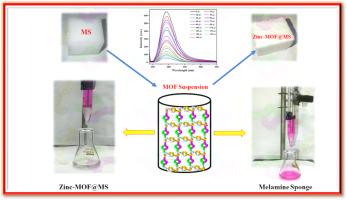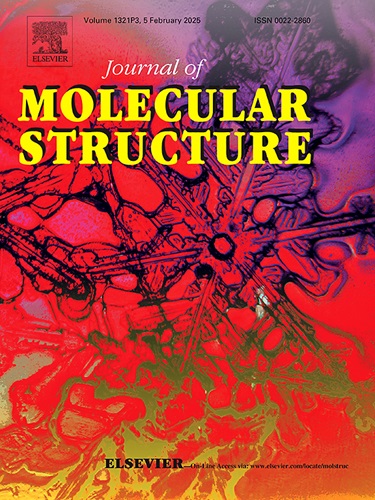Development of colorimetric probe using robust zinc-MOF and its consistent melamine sponge composite: Instantaneous N3–, La3+ sensing and degradation applications
IF 4
2区 化学
Q2 CHEMISTRY, PHYSICAL
引用次数: 0
Abstract
The crystalline sponge method (CSM), which involves soaking a target molecule into a crystalline metal-organic framework (MOF), offers a promising approach by eliminating the need for high-quality single crystals of the target compound. To broaden the scope of compounds that can be analyzed using CSM, it is essential to investigate various MOFs. In this study, we focused on evaluating the potential of a zinc-based MOF, specifically [Zn3(Cei)2((Bimb)3] (Zinc-MOF), as a CSM host. We successfully synthesized and thoroughly characterized Zinc-MOF. Additionally, we developed a Zinc-MOF@melamine sponge (Zinc-MOF@MS) composite, which exhibited significant photocatalytic activity by degrading hazardous organic dyes such as Rose Bengal (RB) and Crystal Violet (CV), achieving degradation efficiencies of 98.95 % and 92.51 %, respectively, after 120 min of exposure to visible sunlight. The luminescent properties of the Zinc-MOF were also explored, demonstrating strong luminescent emission and excellent chemical stability. Furthermore, Zinc-MOF showed remarkable sensing capabilities, selectively detecting La³⁺ cations and N₃⁻ anions in aqueous solutions through luminescence quenching.

利用坚固的锌-MOF 及其一致的三聚氰胺海绵复合材料开发比色探针:瞬时 N3-、La3+ 传感和降解应用
结晶海绵法(CSM)是一种将目标分子浸泡到结晶金属有机框架(MOF)中的方法,无需目标化合物的高质量单晶体,是一种很有前途的方法。为了扩大可使用 CSM 分析的化合物范围,有必要研究各种 MOF。在本研究中,我们重点评估了锌基 MOF(特别是 [Zn3(Cei)2((Bimb)3](Zinc-MOF))作为 CSM 宿主的潜力。我们成功合成了 Zinc-MOF,并对其进行了全面表征。此外,我们还开发了一种 Zinc-MOF@melamine sponge(Zinc-MOF@MS)复合材料,它在降解玫瑰红(RB)和水晶紫(CV)等有害有机染料方面表现出显著的光催化活性,在可见光下暴露 120 分钟后,降解效率分别达到 98.95 % 和 92.51 %。此外,还对锌-MOF 的发光特性进行了研究,结果表明,锌-MOF 具有强烈的发光发射和出色的化学稳定性。此外,Zinc-MOF 还显示出卓越的传感能力,它能通过发光淬灭选择性地检测水溶液中的 La³⁺ 阳离子和 N₃- 阴离子。
本文章由计算机程序翻译,如有差异,请以英文原文为准。
求助全文
约1分钟内获得全文
求助全文
来源期刊

Journal of Molecular Structure
化学-物理化学
CiteScore
7.10
自引率
15.80%
发文量
2384
审稿时长
45 days
期刊介绍:
The Journal of Molecular Structure is dedicated to the publication of full-length articles and review papers, providing important new structural information on all types of chemical species including:
• Stable and unstable molecules in all types of environments (vapour, molecular beam, liquid, solution, liquid crystal, solid state, matrix-isolated, surface-absorbed etc.)
• Chemical intermediates
• Molecules in excited states
• Biological molecules
• Polymers.
The methods used may include any combination of spectroscopic and non-spectroscopic techniques, for example:
• Infrared spectroscopy (mid, far, near)
• Raman spectroscopy and non-linear Raman methods (CARS, etc.)
• Electronic absorption spectroscopy
• Optical rotatory dispersion and circular dichroism
• Fluorescence and phosphorescence techniques
• Electron spectroscopies (PES, XPS), EXAFS, etc.
• Microwave spectroscopy
• Electron diffraction
• NMR and ESR spectroscopies
• Mössbauer spectroscopy
• X-ray crystallography
• Charge Density Analyses
• Computational Studies (supplementing experimental methods)
We encourage publications combining theoretical and experimental approaches. The structural insights gained by the studies should be correlated with the properties, activity and/ or reactivity of the molecule under investigation and the relevance of this molecule and its implications should be discussed.
 求助内容:
求助内容: 应助结果提醒方式:
应助结果提醒方式:


